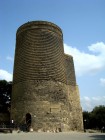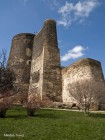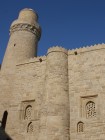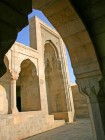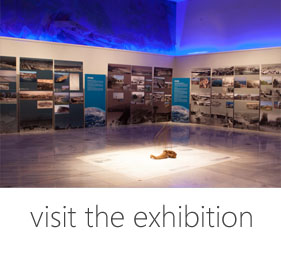Name
Port of BakuCurrent Name
Port of BakuAncient Name
Port of BakuMedieval Name
Port of BakuHistory of the name
The word of “Baku” comes from ancient history and different opinions exist on the origin of the name of the city. One of the most notable versions was put forward by Flinders Petrie, an English Egyptologist, who associated the name of Baku with “Bakhau”, a name mentioned in Egyptian mythology in the “Book of Dead”, the ancient texts of which are dating back to the end of the III millennium BC. F. Petrie also explores the connection between ancient Azerbaijan and Egypt, which is evidenced by a range of archeological findings made of blue Egyptian clay and discovered in the territory of Azerbaijan. According to F.Petire, some of the old Egyptian myths are one way or another, linked to the rituals of sun worship which originate from Azerbaijan.
Place :
Country
AzerbaijanGeopolitical Unit
Baku cityAdministrative subdivision
Sabael districtLocation
The Port of Baku located in Baku, capital of Azerbaijan. Lying on the western shores of the Caspian Sea about 700 kilometers east-southeast of the Port of Batumi, in Georgia, the Port of Baku is blessed with the best harbor in the Caspian because the bay is sheltered by the islands of the Baku Archipelago to the east and the Absheron Peninsula to the north.Foudation Date
Archaeological evidence suggests human settlements in the area of the Port of Baku several centuries before the coming of Jesus, but the Port of Baku was first noted in written records from 885AD. The Baku International Sea Trade Port has been the biggest and busiest port on the Caspian Sea since it was established in 1902.Current condition
In 2012, over 2 million people lived in the Port of Baku. From a couple of modest wooden jetties and a handful of dockers in its first days the port has been constantly developing over the century and now plays an important role in trans - Caspian trade and is the main marine gateway to Azerbaijan. Beginning as a humble two-jetty port with a few workers, it has grown to be the gateway for water-borne traffic to Azerbaijan. The port operates year-round and as a vital transit point in Europe-Asia trade that is being promoted within TRACECA - RESTORATION OF THE HISTORIC SILK ROUTE project. With the dramatic increase in trans-Caspian oil trade volumes and enormous import to Azerbaijan various equipment for offshore oil activities over last decade the port has further strengthened its importance. Open all year on the ancient Silk Route, the Port of Baku is an important transit point for trade between Europe and Asia. When the rivers of Russia are open from April through November, the Port of Baku serves ships carrying cargoes from Western Europe and the Mediterranean to inland Russia. Its importance has grown with increasing trade of oil in the trans-Caspian region and growing offshore drilling in the last decade. According to the Order of the President of the Republic of Azerbaijan on the ‘Construction of New Baku International Sea Trade Port Complex’ signed on March 18, 2007 the existing sea trade port will be demolished, and a new port complex will be constructed at Alyat settlement, 65 km south of Baku. The new port will provide general cargo and passenger terminals, cargo handling and Ro/Ro facilities, rail ferry terminal connecting the ports of Aktau and Turkmenbashi as well as International Logistics Centre. Construction of the Port Complex will be completed in three stages in 2014.History
The Port of Baku was first noted in written records from 885AD. In the 11th and 12th Centuries, the Shirvanshahs made the Port of Baku their capital. During the 13th and 14th Centuries, it was overrun by the Mongols.Peter the Great captured the Port of Baku in 1723, but it came back to Persia in 1735. Finally in 1806, Russia captured the city. It became the capital of the Azerbaijan Republic in 1920.
Commercial exploitation of the Port of Baku's oil resources began in the early 1870s. By the early 20th Century, the Baku oil field was the world's largest, and it continued to be the Soviet Union's biggest oil field until the 1940s.
By the end of the 20th Century, most of the easy-to-get oil reserves in the Port of Baku area had been taken, and drilling underground and into the seabed began. When Azerbaijan won its independence, foreign oil companies bought rights to explore for and develop oil-rich sites near the Port of Baku. New refineries appeared, and many oil derricks rose in the gulf in front of the city.
The center of the modern Port of Baku is dominated by the ancient old town fortress of Icherisheher (Old city of Baku). Still standing are the walls that were reinforced after the 1806 Russian conquest and the Maiden Tower.
Today's Port of Baku rises up the hills that surround the bay with regular streets and modern buildings. The waterfront boasts a beautiful park, and most of the industrial areas are to the east and southwest of the city. Today, the city almost covers the entire Absheron Peninsula and off-shore islands.
Description
Fortress walls
Baku city was surrounded by huge double fortress walls from north, east and west in the Middle Ages. According to the sources the city was surrounded by fortress walls also from the south and the Caspian seaside. There were 5 entrance doors to the city through the fortress walls.
In 1868 the military governor of Baku addressed to the Caucasian Military Command regarding demolishing of the fortress walls in order to beautify the city and liquidate the walls as military protective bastion. Two years later demolishing of the second wall outward was permitted. This issue was repeatedly brought up in the meeting of Duma in 1886, and subsequently, the door named “Zulfugar khan’s gate” in the second demolished fortress wall was constructed next to the Shah Abbas’ gate in the first fortress wall. According to the epitaph on the stone funerary monument discovered during restoration works, the fortress walls were constructed upon decree by Shirvanshah III Manuchokhr approximately in 1138-1139. Due to being often destructed during enemies’ attacks the fortress walls were repeatedly restored. Presently about 600 meter of the fortress walls of Icherisheher the length of which was 1500 meters in middle ages had survived. Plasterboard solution was used as fixing material for masonry of the fortress walls. Presently the width of the wall is 3-3,5 meters and the height is 8-12 meters.
Maiden Tower
Maiden Tower, erected at the coast of the Caspian Sea preserved its magnificence till our days. The Tower, which was included into the fortification system of Baku, was called “Maiden Tower” for its inaccessibility. Maiden Tower is a cylindrical shaped tower built at the coast rock. From the sea side the oblong prop (counterfort) adjoins the tower. The height of the tower is 31meters from the north and 28meters from the south. It should be noted that there are some versions concerning the figure “28”. The facts that Caspian Sea is below the world sea level by 28 meters, there are 28 blocks in Icherisheher, the Fortress walls connect 28 semicircular towers, indicate the symbolic character of this figure. The diameter of the Tower is 16meters on the ground floor, and thickness of wall is 5 meters on the ground floor. The Tower consists of 8 floors. Each of the eight floors is covered with the stone cupola with round hole in the center. The holes of the cupolas are arranged in such a way that it is possible to see the floor of the ground floor when looking through the openning in the central part of the ceiling of the eighth floor. The single entrance into the Tower is the arched doorway on its western side. The ground floor of the Tower is 3 meters high, the height of the other floors is on the average 2,5 meters. The connection between the floors is supported by staircases built in the thickness of the south-eastern wall of the tower. At medieval times there was no staircase on the ground floor and therefore the access to the first floor was possible only by lowering the rope or ladder through the circular hole on the ceiling. The door of the tower was also made of several firm layers. This fact is proved by the remains left on top of the arched door way, the length of which is equal to the width (5 meters) of the Tower wall. In order to keep under control the sea and southern and south-eastern sides of the Tower, special loopholes were made on the walls. These loopholes were intended for the circulation of fresh air, as well.
In 1962-63 archeological excavation works were carried out on the ground floor of the Tower. As a result of the digging down to a depth of 5 meters, it was found out that the foundation of the monument was built on a huge rock with slope to the sea. We can come to a conclusion that the counterfort adjoining the monument from the sea side plays the role of a main prop of the Tower in front of this slope.During the archeological research works carried out in 1964, from the foundation of the Tower there were found big logs 14 meters high, which stretched to the interior of the monument. Even today, the main function of these logs is not known. It is possible that, these logs relate to a special construction inside the counterfort, or protect the building against earthquake.
There are various suppositions and legends about the date of construction and function of the tower. Some of the scientists suppose that the Tower was built in two different periods. According to this supposition, the lower part of the tower with smooth wall up to 12 meters is older and dates back to the VIII-VII centuries BC. The upper part surrounded with stone stripe is supposed to be built later.
Accurate calculations defined that the width of the Tower wall is 5 meters at the bottom and 4.5meters at the top. This fact shows that the lower and upper parts of the monument were not built in different periods as stated by some scientists, but in the same period. Because, the wall 5 meters wide helped the both parts of the Tower stand on firm foundation. The secret of preservation of the Maiden Tower till our days is its construction on such a firm foundation. One of the interesting features in the construction structure of the Maiden Tower is a well dug out on a rock. From the level of the ground floor to the depth of 5 meters the well was built out of well hewn stones. This well 21 meters deep is in the thickness of the south-eastern wall of the Tower, and its diameter is 0.7 meters. Excavation works were carried out in this well. Material cultural remnants found in the well show that it was used starting from the XII century. According to the calculations it was determined that the well has no connection with the sea level.
Chemical analysis also proved that water in the well is good for drinking. The mouth of the well starts from the level of the third floor and goes down 13meters along the wall of the Tower. The well was hidden inside of the Tower walls for security reason. On the northern and southern walls of the well there are foot-places 10-12cm deep for going up and down. The diameter of the well widens at the depth of 12 meters. There is a supposition that the underground passage between Maiden Tower and Shirvanshahs’ Palace starts from the bottom of the well. The first underground passage was discovered as a result of the large-scale archeological excavations carried out at the eastern part of Icherisheher in 1982. This passage is located on the eastern part of the main street leading from Shamakhi Gate, which was the central trade street of Baku at medieval times, to Salyan Gate. It is interesting that this way passes under Multani caravanserai of the XIV century and goes in the direction of the Maiden Tower.
Mohammed Mosque
The Mohammed mosque is a monument from the ancient Islamic period of Icherisheher. On the northern facade of the mosque there is an inscription in Arabic: this mosque was constructed by Al UstaderRais (Chief Master) Muhammad ibnAbubekr h 471( 1078-79).
In the history of Azerbaijan architecture, minarets play an important role. The minaret next to the Mohammed Mosque, was built in the year 1078 and is a particularly archaic structure. In its way of construction it is typical of the northern regions of Azerbaijan. It was included in the UNESCO World Heritage List because of its significance as an outstanding building.
The Shirvanshahs’ Palace Complex
Complex of Shirvanshahs’ Palace was the last residence of the rulers of Shirvan State with the history of thousand years. At medieval times this state was the most powerful state in Azerbaijan. While in the south of Azerbaijan old and new feudal states replaced each other, in its north the borders of Shirvan state stretched up to Derbend, the south of Daghistan. In the historical literature the history of Shirvanshahs’ state is divided into four periods: the first Shirvanshahs, Mazyadids, Kesranids and Derbendis. The first capital of Shirvanshahs’ state was the city of Shamakhi. After the devastating earthquake that took place in Shamakhi in 1197, Shirvanshah moved the capital to Baku. However, long before the earthquake, during the reign of Shirvanshah Manuchohr III (1120-1160) the fortress walls of old Baku were built.The Complex of Shirvanshahs’ Palace was erected on one of the highest points of Icherisheher, in a densely populated area. The construction work was not confined to the single architectural plan. However, taking into consideration the purpose of each building of the Complex, the masters could place them in order of importance and could create a beautiful scenery.
The foundation of the Palace was laid in the XIIth century and the construction was completed in the XVth century. The Palace consists of three internal courtyards at different levels. The Palace and the Mausoleum of Shirvanshah Farruh Yaser (the Divankhana) are in the upper courtyard while the palace mosque and the Shirvanshahs’ mausoleum are in the lower courtyard. The mausoleum was built by order of Shirvanshah Khalilullah for his son and mother. The Hamam and the ovdan (storage lake) are located in the lower courtyard. The three courtyards together form the complete complex surrounded by the fortress walls. The single monument in the complex attributed to XVIth century is the “Murad Entrance.” The inscription on its surface states that it was built in honor of Sultan III Murad in 994 Hegira (1585-86 AD).
Harbor
The Baku International Sea Trade Port is comprised of Main Cargo Terminal, Dubendy Oil Terminal, Ferry Terminal and Passenger Terminal. The port`s throughput capacity has been constantly growing and reaches up to 15 million tons of liquid bulk and up to 10 million tons of dry cargoes.
Due to its modern facilities and year-round accessibility the port maintains its competitiveness and is widely used by international traders.
Services rendered to the users of the port include:
• Dry cargo and liquid bulk handling
• General and project cargoes
• Container handler (stuffing/stripping)
• Warehousing and storage
The main cargo terminal in the Port of Baku serves vessels carrying containers and bulk and general cargoes. The largest share of goods is in general cargo, and the Port of Baku's main cargo terminal has capacity to handle two million tons of general and dry bulk cargoes per year. The terminal contains six berths totaling 866 meters in length with alongside depth of seven meters. One of the berths is the Port of Baku's roll-on/roll-off quay. The berths are fully equipped with 16 cranes to handle up to three vessels at one time, and they are served by eight kilometers of railway. The main cargo terminal offers 24 thousand square meters of open storage and about 10 thousand square meters of covered warehouse.
Near the Port of Baku's main cargo terminal is the Container Terminal with capacity to handle 15 thousand containers per year. The Container Terminal has 1.6 thousand square meters of warehouses and is linked to the Port of Baku's main railway system.
Some 35 kilometers to the east-northeast of the Port of Baku is the Oil Terminal at Dubendi. The Oil Terminal handles oil from Azerbaijan, Kazakhstan, and Turkmenistan that is destined for ports on the Black Sea and the international market. The Port of Baku Oil Terminal has two piers that can handle four tankers at the same time. The Oil Terminal has capacity to handle 15 million tons of cargo per year. When the Baku-Tbilisi-Jeyhan oil pipeline is completed, the Port of Baku will serve as a transit point for significantly larger volumes of oil to international markets. The Oil Terminal is equipped to receive contaminated waters and to clean up accidental discharges of oil.
The Ferry Terminal at the Port of Baku serves passengers, vehicles, and cargo traveling between Baku and Iranian ports. Each ferry can accommodate 28 wagons or 40 trailers as well as over 200 passengers and as many as 50 cars. The Ferry Terminal at the Port of Baku has capacity to handle up to eight million tons of cargo per year. As an important stop on the Tracea-Restoration of the Historic Silk Route project, the Port of Baku anticipates a dramatic rise in traffic through the Ferry Terminal over the coming years.
The Port of Baku's port fleet includes 20 vessels that are housed at the Port Fleet Terminal. The terminal is also the arrival/departure point for cruisers used by the municipal government and the citizens of Baku.
The Passenger Terminal in the Port of Baku contains a 340-meter long berth used by passenger ships moving between ports on the Caspian Sea. It is also used for transporting oil workers to and from their duty stations.
Baku has attracted traders from all over the world since ancient times. Extracted oil and salt, as well as saffron exported to various Eastern countries were a major impetus for the growth of Baku as a city. In addition, the extraction of oil stimulated the development of crafts related to the oil industry such as the production of vessels which were made of clay and seal skin for the transportation of oil.
Baku played an important role in the silk trade and at the same time, it possessed great significance as the city of oil, exporting much of this oil to Iran, Russia and other countries.
In the XVII-XVIII centuries, Baku was the main port on the Caspian Sea in terms of international transit and trade between the East and West, a fact that was referenced by many travelers of the time. Baku played an important role in strengthening of the trade connections with Western European countries and with Russia.
Fortification
A unique monument of medieval Baku which is no longer in existence is the Sabail, or “Bayil stones”. Constructed during the years 1234 – 35 in the sea, the Sabail was a strong sea fortress, as well as the residence of the Shirvanshahs. The fortress was submerged as the result of an earthquake in 1306. Since first part of 18 century it has been reduced the level of the Caspian Sea resulted as discovered of water walls and towers of the building. Inscriptions were in high relief, with decorations and ornamental heraldic character, accompanied by images of human faces, real and imaginary animals. At the present time in Shirvanshahs’ Palace are presented unique walls of Bails discovered from the sea in 60 years of 20 century. From 1939 till 1960 there were discovered 699 water walls consist of huge information of the history about Shirvanshahs.
Medieval Sites
Museums
There is a museum complex in Icherisheher comprised of «Maiden Tower», «the Palace of the Shirvanshahs», the Museum of Miniature Books, the House museum of Kamil Aliyev, the House museum of Vagif Mustafazade, the House museum of Tahir Salahov and Museum of Numismatic Exhibition. Visitors can also visit various exhibition halls and galleries where they can discover and purchase beautiful pieces of handcrafted art from various artists, sculptors and masters of handicraft.
The Maiden Tower
The Maiden Tower is located in the southeastern part of the walled city of Baku. This monument is in the form of a giant cylinder which is 28 meters in height. The thickness of the tower walls is 5 meters at the base and 4 meters on the top floor. The tower has 8 arches which divide it into 8 floors. The extraordinary shape of the monument evidences its antiquity. Some researchers suggest that the monument was a place for fire-worship and they attribute it to the VIII -VII century BC.
The Shirvanshahs’ Palace
The medieval Shirvanshahs’ Palace Complex is located on one of the hills in Icherisheher. The foundation of the Palace was laid in the XIIth century and the construction was completed in the XVth century. The Palace consists of three internal courtyards at different levels. The Palace and the Mausoleum of Shirvanshah Farruh Yaser (the Divankhana) are in the upper courtyard while the palace mosque and the Shirvanshahs’ mausoleum are in the lower courtyard. The mausoleum was built by order of Shirvanshah Khalilullah for his son and mother. The Hamam and the ovdan (storage lake) are located in the lower courtyard. The three courtyards together form the complete complex surrounded by the fortress walls. The single monument in the complex attributed to XVIth century is the “Murad Entrance.” The inscription on its surface states that it was built in honor of Sultan III Murad in 994 Hegira (1585-86 AD).
The “Bayil Stones” are also kept in the Shirvanshahs’ Palace Complex. These stone slabs are covered with inscriptions and images and are the remains of the Bayil Castle which was a defense fortress of the Shirvanshahs. The stone slabs are of various sizes:0,73x0,30m; 0,73x0,45m; 0,71x0,25m; 0,66x0,35, and are 13-15 cm thick. The slabs were discovered as a result of archeological excavations done around the fortress building. According to the dates inscribed on them, these stone slabs can be attributed to the XIIth century.
Museum of Miniature Books
The Museum of Miniature Books, the only privately owned museum of this kind in the world, opened in Icherisheher on April 23, 2002. Mrs. Zarifa Salahova, the museum founder, has collected more than 6,000 miniature books for 27 years. At present, 4,350 miniature books published in 62 countries are on display in the museum. The first miniature book purchased by Mrs. Salahova in 1982 was the book of fables of Ivan Krylov, published in 1835. The works of the Azerbaijani prominent classical poets - Nizami, Fizuli and Nasimi are exhibited in this museum. You can also find a miniature Koran and other religious books, in addition to miniature work by such international authors as Jack London, Honore de Balzac Gustave Flaubert, etc. The collection of Mrs. Salahova is constantly expanding with new miniature editions from all over the world.
The House Museum of Kamil Aliyev
It is impossible to express the uniqueness of the Azerbaijani carpets with words! The riot of colours, the motives rich of ornaments, and unique mixture of themes are all hallmarks of the detailed, long time work of Azerbaijani carpet makers. In an Azerbaijani home, carpets are always in plain view, whether displayed on a floor, hung on a wall, given as a dowry, inherited or given as a gift for a special occasion. Carpets are also presented as gifts to diplomats and heads of state. Exactly the carpets of this kind were weaked by Kamil Aliyev (1921-2005). The mainest merits of Kamil Aliyev are using the innovative Azerbaijani traditions of decorative and applied arts to create a realistic portrait genre in carpet weaving art. He was one of the first Azerbaijani artists to depict portraits of famous people on carpets. The House-museum of Kamil Aliyev is situated in a four-storeyed stone building where the artist lived only for 11 months before his death at the age of 83. The museum displays 127 of Aliyev’s carpets as well as some works that were never completed.
The House Museum of Vagif Mustafazade
Vagif Mustafazade (1940- 1979) is a outstanding Azerbaijani jazz composer and pianist. The music of Vagif Mustafazade continues to captivate the audiences with its uniqueness, virtuosic technique and with its distinctive and harmonic language. Mustafazade was the first musician who applied an Azerbaijani music style in jazz compositions as well as in synthesized mugam. Not only was he was a pioneer of Azerbaijani jazz, creating his own unique jazz pieces and musical adaptations, he was also a well known author of symphonic and chamber music.
The House Museum was established in 1989 and there are more than 1,214 artifacts from Mustafazade’s life which include artwork, household articles and his personal belongings, as well as photos, posters, gramophone records and documents related to his life. The 70th anniversary of Vaqif Mustafazade was celebrated in 2010 and many events were organized for the celebration.
The House museum of Tahir Salakhov
Mr. Tahir Salakhova is living legend of world culture. October 13, 2011 by the decree of the President of the Republic of Azerbaijan Ilham Aliyev has been established house - museum of Tahir Salakhov. Museum is located in the central part of the Old City and occupies is 500 square meters. The museum consists of fine art, photographs, books, carpets and other goods, as well as from the archives and personal items. The museum exhibition of works rearranged Tahir Salakhova. In addition, the museum has been actively involved in organizing events and plays a major role in shaping the tastes of the younger generation. The main purpose of the museum - the study of fine arts and the promotion of creativity Tahir Salakhova locally and globally.
Numismatic Exposition
Exhibition of numismatic exposition was opened for the first time in 2011, the Old City in Baku, Azerbaijan. This exhibition is one of the main attributes of statehood of Azerbaijan, consists of coins reserve was created in the one of the ancient mosques. The mosque is located near Shirvanshah's palace that was built in the XIV century. Mosque consists of the one is a room that is the local mosque. At the time of the creation of the exposition it was taken into consideration 8-pointed emblem form the basis and was used into the interior. The main subject of the exhibition is related to the V century of BC - first half of the nineteenth century period covering the business of minting the coins.
The exhibition presents the history of coins spanning 2,500 years of history of the history of the state and municipalities, as well as coins minted in foreign countries, displayed in a special showcase. Here is exhibited exposure of commodity exchange from time to cash exposures finishing coins until the early nineteenth century. In each window, along with the coins in interior design, there are also various artifacts related to the same periods - clay, copper utensils, weapons, jewelry. In the creation of the exhibition were also made 2 cards as interactive materials. 2 as benefited from new settings. In topographic maps display information about the coins that were used on the territory of Azerbaijan and foreign countries.
The exhibition provides also showcase is directly linked with the treasure of copper coins Shirvanshahs. The exhibition as a whole reflects the history of the state of the Azerbaijani people.
Textual Sources
Bibliography
• Ahmadov Q. New Views on Maiden Tower. Science and Life, 1986 issue 7.
• Ashurbeyli Sarah. On the Date and Purpose of Maiden Tower in the Fortress// Academy of Sciences of the Azerbaijani SSR, 1974 issue 3.
• Imanov Kamran. IcheriSheher – A Monument Composed of Monuments // Echo Newspaper, 7 March 2009, issue 44.
• Neymat M. Plan of the Epigraphic Monuments of Azerbaijan T.I, 1990.
• V.N.Leviatov, Arkheologicheskiyeraskopki 1946 v krepostnoychastigor( Baku, Publishing House of the National Academy of Science of Azerbaijan SSR).
• F.A.Ibrahimov and K.F.Ibrahimov, BakiIcheriSheher (Vol.1, Baku, 2002).
• O.Sh.Ismizade, H.A.Jiddi, BakiQizQalasi (Baku,1968).
• S.B.Ashurbeyli,Istoriyaqoroda Baku (Baku,1992).



